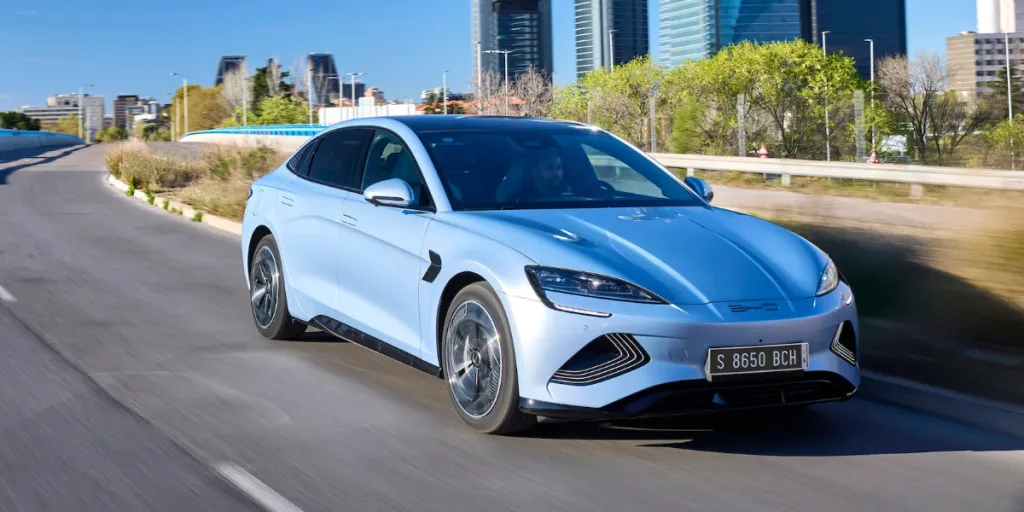Attaining a twelve per cent share of its home market during September was quite the achievement (VW: ten per cent and Toyota eight per cent). And yet not too long ago, the company’s decision to end production of IC-only models seemed unnecessarily risky. Instead, it seems to have been a masterstroke as buyers continue to leap on BYD brand hybrids, PHEVs and EVs month after month.
According to the firm’s own data, deliveries for the first nine months hit 2,079,638 units, that being a remarkable year-on-year gain of 75.5 per cent. In September alone, the total was 287,494 of which 151,193 were EVs. And as for sales of BYD electric vehicles in markets outside China, these numbered a further 28,039 vehicles in September and 145,529 year-to-date.
The Chinese OEM also continues to expand into many overseas markets, its cars and SUVs being not only strikingly affordable but also seemingly strong on quality and desirability. The next big test will be how to keep sales rising, along with margins. This report aims to lift the lid on what BYD plans to do next.
Tesla’s Model Y might remain China’s best selling passenger vehicle but in September, multiple BYD cars were snapping at its heels. In fact, half of September’s top ten models wore a Build Your Dreams badge, these being in order of sales performance: Qin Plus (2nd), Song Plus (3rd), Seagull (4th), Yuan Plus (7th) and Dolphin (10th).
Let’s briefly look at the life cycles of some of these models. The Qin Plus, a sedan, which is about to turn two, is derived from the older Qin Pro. There are both PHEV and EV variants, each of which should be replaced in 2026/2027.
Coming soon – for international markets at least – is the Song U. The company’s Song models are now many so names can be confusing. But this one is simply a rebadging of the Song Plus. This crossover, launched in China three years ago, remains a big seller, as witnessed by its performance in the September market. The U was recently revised and itself renamed to Song Champion Edition. The successor should be launched in 2026.
BYD previewed yet another new model in August, a fastback SUV called Song L. The 4,840 mm EV, which debuted at the Chengdu motor show, is set for launch in December. It will be offered with the choice of a 230 kW single motor or a combined 380 kW via two motors. All variants will have the brand’s ‘Blade’ battery.
It was a busy time for the company this past northern hemisphere summer, with the Seal DM-i PHEV also appearing. Not to be confused with the Seal (pictured), a different model which is an EV, this plug-in hybrid is off to a good start sales-wise. Incidentally, whilst the badging is Seal DM-i PHEV, the car can also be referred to by its maker as Corvette 07 or Frigate 07.
BYD manufactures the Seal DM-i PHEV at its newest plant: Zhengzhou in Henan. Opened in April with an initial capacity of 400,000 vehicles per annum, two SUVs are also produced there. These are the Song Champion Edition/Song U and Song Pro.
The Seagull is yet another recent arrival, this being a small electric hatchback. Revealed in April, it is 3,780 mm long with a 2,500 mm wheelbase. The battery chemistry is LFP and the manufacturer FinDreams, a BYD offshoot. Production at the firm’s Shenzhen plant started a few months ago and should continue until 2029 after a facelift in 2026.
With the Seagull now positioned into the A segment, BYD has completed its project to offer small electric hatchbacks in the 3.5-4.5 m classes. The new model supplements what quickly became a brisk seller in the B segment since its arrival in 2021 – the Dolphin. BYD is also exporting this model to many markets in Europe, Asia and even South America. Its replacement is due in 2027 after a facelift towards the end of 2024.
What’s coming next?
One of the more intriguing projects is an electrified pick-up, this segment of the Chinese market having been greatly expanded in the last year or two. In fact, BYD’s entry is almost overdue, such are consumers’ expectations of the brand’s reputation for being early into electrified vehicle classes which soon grow exponentially. Will this one be next?
China’s notoriously leaky MIIT (Ministry of Industry and Technology) recently allowed some images of a BYD pick-up into the public domain. The model might even be officially revealed before the end of 2023. Indeed, from what was leaked, the prototype looks almost production-ready. So what can be gleaned from both MIIT’s information and BYD’s own internal leaks?
The brand’s first such model will have four full-size doors with a mainly conventional look in the style of the Ford Ranger. However, the front end will feature a large plastic panel where the grille would normally be. That suggests the pick-up will be an EV. Yet sources claim there will be two propulsion choices, one of which will indeed be electric, the other being a 1.5-litre range extender powertrain. This may even be a PHEV system.
BYD’s expansion will continue into other segments with the launch of what is expected to be a new luxury MPV in the full-size class (i.e. 5+ metres long). Due in the second half of next year, it would be logical if this model – it could be called ‘Ming’ – was based upon the existing Denza D9. Geely has adopted a similar strategy for its imminent Volvo EM90, itself an adaptation of the Zeekr 009.
Source from Just-auto.com
Disclaimer: The information set forth above is provided by Just-auto.com independently of Alibaba.com. Alibaba.com makes no representation and warranties as to the quality and reliability of the seller and products.




